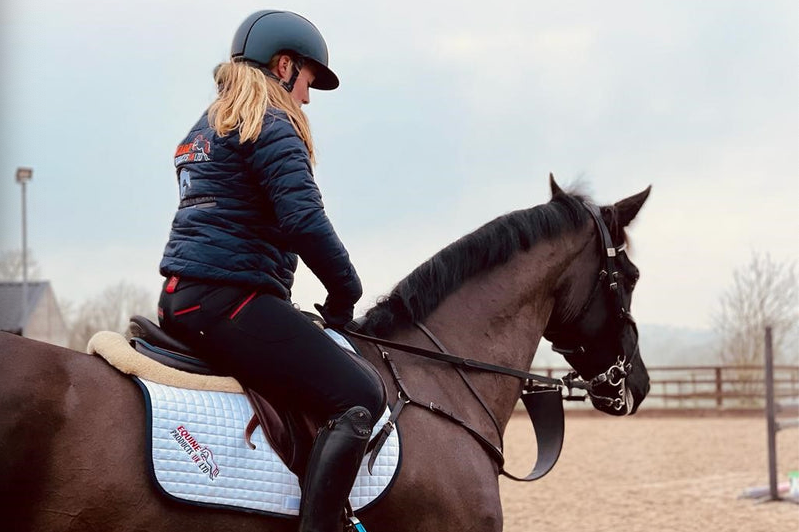Spooky Behaviour?

Written by Briony Witherow MSc. RNutr.
Spooky Behaviour?
There are many reasons why our horses might be just that little more on edge at this time of year, whether it be a night disturbed by fireworks, colder weather or simply more time spent in the stable and less in the field.
Whatever the reason behind it, it may be that you and your horse could benefit from some proactive management to ensure that your feeding isn’t a contributing factor, and knowing where to turn if you need a helping hand.
The bigger picture
Feed-based causes of excitement or unwanted behaviour can usually be broken down into three key issues:
- Excess Energy
More energy is being provided by the ration than the horse is expending, resulting in excess energy (either expressed in behaviour and/or being laid down as fat).
- Too Much Starch and Sugar
Too much starch and sugar in the ration provides fast release energy that may contribute to spooky or excitable behaviours. The way in which the horse’s body digests starch and sugar, means that it is available in the blood stream within 45 minutes, causing a spike in blood sugars – just like the equivalent of us eating a Mars Bar! The effects of this will be magnified if your horse is spending more time stabled, meaning that his opportunity to express this energy is during exercise!
- Digestive Discomfort
What we interpret as poor or even spooky behaviour can also be caused by discomfort, in feeding terms, this could be that our horse is spending long periods without forage.
While we are often restricted in our ability to provide more turnout time by our yard, amount of pasture and soil type, we can do our best to adjust feeding to reflect new management conditions.
So, what can we do to optimise the diet and reduce the risk of feed related issues?
Forage
Ensure that your horse is consuming at least 1.5% of his bodyweight in dry matter of forage per day. While pasture will contribute to this, be careful not to overestimate how much grass is available, particularly as the winter progresses. Walk pasture regularly and assess how much grass is available on the lawns (areas where horses graze) rather than the roughs (latrine areas, where the horse defecates).
If you have the flexibility to do so, selecting the most appropriate hay or haylage for your horse, can help to optimise the ration for both good and poor doers.
For poor doers, selecting an earlier cut (soft in the hand) hay or haylage which is more digestible (and often more palatable) can reduce reliance on hard feed (typically reducing starch and sugar intake) and make maintaining weight over the winter months easier.
For the good doer, choosing a later cut hay (crunchy in the hand) often means that you can feed more, which results in less time without forage!
You can also experiment with slow feeders (for poor and good doers) to extend the time which they are occupied and chewing forage and to enrich their stable environment. Mixing up forage presentations, for example, using hay in a net, in a ball and on the floor can help to encourage natural foraging behaviours, keep horses entertained and reduce stress.
Bucket Feed
Depending on how your horse’s management and exercise regime changes over the winter months, your feeding should reflect this. The more proactive we can be with our changes, the less likely we are to experience issues which arise from a mismatch of diet and requirement. Try and take a step back and reflect on how and what may change over the winter – do you ride less frequently or the same number of days but for shorter durations? OR is winter the main time when you compete and ride? Whatever the changes may be, does the feed regime reflect this?
Energy/Calories
If you are finding yourself with too much energy or even weight gain, reduce feeding quantity where possible and, if feeding less than the recommended amount for size and workload, consider either taking a step down to a lower calorie/energy product OR add a feed balancer. The latter can work well and be a more flexible solution year-round, avoiding lots of feed changes.
Starch and Sugar
Consider the starch and sugar levels in your bucket feed. Remember to consider the percentage stated in light of the amount fed.
For example, if one product states starch of 20% and sugars at 8% but the feeding rate was 100g per 100kg bodyweight (ie 500g for a 500kg horse), this would be a total of 100g of starch and 40g of sugar. Whereas another product with a starch of 8% and sugar of 4% but fed at 500g per 100kg bodyweight, (2.5kg for a 500kg horse) would be a total of 200g of starch and 100g of sugar.
So, despite the first product seeming higher in starch and sugar, because the feeding rates are lower, it contributes less starch and sugar to the diet.
Supplements
Once you have checked-off the forage and bucket feed, and made sure these aren’t likely to be contributing to spooky behaviour, we can look at supplements which can be added to give you a further helping hand.
We mentioned that digestive discomfort may cause what we perceive as unwanted behaviour, so adding a supplement which provides digestive support particularly during changes in management will help to support the hindgut environment and general gut function. A pre and probiotic such as Transvite would be suitable for this purpose. Alternatively, calmers which offer a two-prong approach, containing both active ingredients which help to calm alongside digestive support (such as Cool It Powder or Paste), can help to both proactively address any digestive discomfort, as well as helping horses to deal with short and long-term stress.
